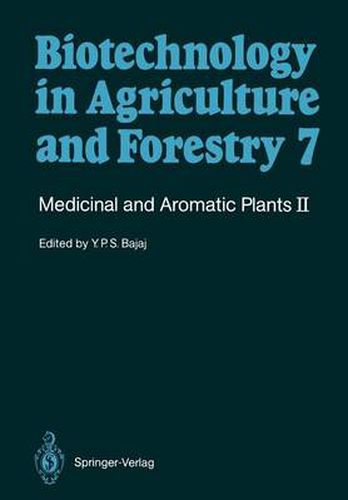Readings Newsletter
Become a Readings Member to make your shopping experience even easier.
Sign in or sign up for free!
You’re not far away from qualifying for FREE standard shipping within Australia
You’ve qualified for FREE standard shipping within Australia
The cart is loading…






This title is printed to order. This book may have been self-published. If so, we cannot guarantee the quality of the content. In the main most books will have gone through the editing process however some may not. We therefore suggest that you be aware of this before ordering this book. If in doubt check either the author or publisher’s details as we are unable to accept any returns unless they are faulty. Please contact us if you have any questions.
Plants are a major source of medicines, flavors, fragrances, and various pharmaceutical and industrial products. Biotechnology is being put to the service for mass clonal propagation of plants, and to produce impor- tant secondary products in cell cultures. In some cases cell cultures ac- cumulate higher amounts of products than the intact plant cells in situ, and such cultures can be stored through immobilization and cryopreser- vation. An in vitro-produced anti-inflammatory drug, shikonin, has been commercialized, and the recent observations on the increased pro- duction of atropine and hyoscyamine by Agrobacterium rhizogenes- mediated transformed hairy roots have encouraged the acceptance of such biotechnologies by the pharmaceutical industry. In an earlier volume, Medicinal and Aromatic Plants I, various aspects of in-vitro culture of cells, bioreactors, micropropagation, im- mobilization, and cryopreservation were discussed. The present volume concerns the application of these biotechnologies to 29 genera of medicinal and aromatic plants. It deals with the distribution, economic importance, conventional propagation, micro propagation, review of tissue culture studies, and the in-vitro production of important medicinal and pharmaceutical compounds in various species of Angelica, Anisodus, Basel/a, Bupleurum, Camellia, Co ix, Coptis, Cryp- tomeria, Datura, Dioscorea, Foeniculum, Gardenia, Geigeria, Heimia, Humulus, Hyoscyamus, Jasminum, Macleaya, Mucuna, Nicotiana, Pimpinel/a, Rauwolfia, Ruta, Salvia, So/anum, Saponaria, Stevia, Tabernaemontana, and Zingiber. The potential role of biotechnology for industrial production is discussed. Biotechnology enables the production and isolation of products of higher purity and also opens the possibility of making desired molecular alterations in products.
$9.00 standard shipping within Australia
FREE standard shipping within Australia for orders over $100.00
Express & International shipping calculated at checkout
This title is printed to order. This book may have been self-published. If so, we cannot guarantee the quality of the content. In the main most books will have gone through the editing process however some may not. We therefore suggest that you be aware of this before ordering this book. If in doubt check either the author or publisher’s details as we are unable to accept any returns unless they are faulty. Please contact us if you have any questions.
Plants are a major source of medicines, flavors, fragrances, and various pharmaceutical and industrial products. Biotechnology is being put to the service for mass clonal propagation of plants, and to produce impor- tant secondary products in cell cultures. In some cases cell cultures ac- cumulate higher amounts of products than the intact plant cells in situ, and such cultures can be stored through immobilization and cryopreser- vation. An in vitro-produced anti-inflammatory drug, shikonin, has been commercialized, and the recent observations on the increased pro- duction of atropine and hyoscyamine by Agrobacterium rhizogenes- mediated transformed hairy roots have encouraged the acceptance of such biotechnologies by the pharmaceutical industry. In an earlier volume, Medicinal and Aromatic Plants I, various aspects of in-vitro culture of cells, bioreactors, micropropagation, im- mobilization, and cryopreservation were discussed. The present volume concerns the application of these biotechnologies to 29 genera of medicinal and aromatic plants. It deals with the distribution, economic importance, conventional propagation, micro propagation, review of tissue culture studies, and the in-vitro production of important medicinal and pharmaceutical compounds in various species of Angelica, Anisodus, Basel/a, Bupleurum, Camellia, Co ix, Coptis, Cryp- tomeria, Datura, Dioscorea, Foeniculum, Gardenia, Geigeria, Heimia, Humulus, Hyoscyamus, Jasminum, Macleaya, Mucuna, Nicotiana, Pimpinel/a, Rauwolfia, Ruta, Salvia, So/anum, Saponaria, Stevia, Tabernaemontana, and Zingiber. The potential role of biotechnology for industrial production is discussed. Biotechnology enables the production and isolation of products of higher purity and also opens the possibility of making desired molecular alterations in products.